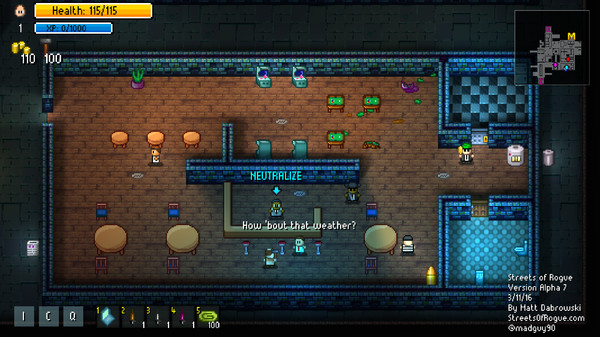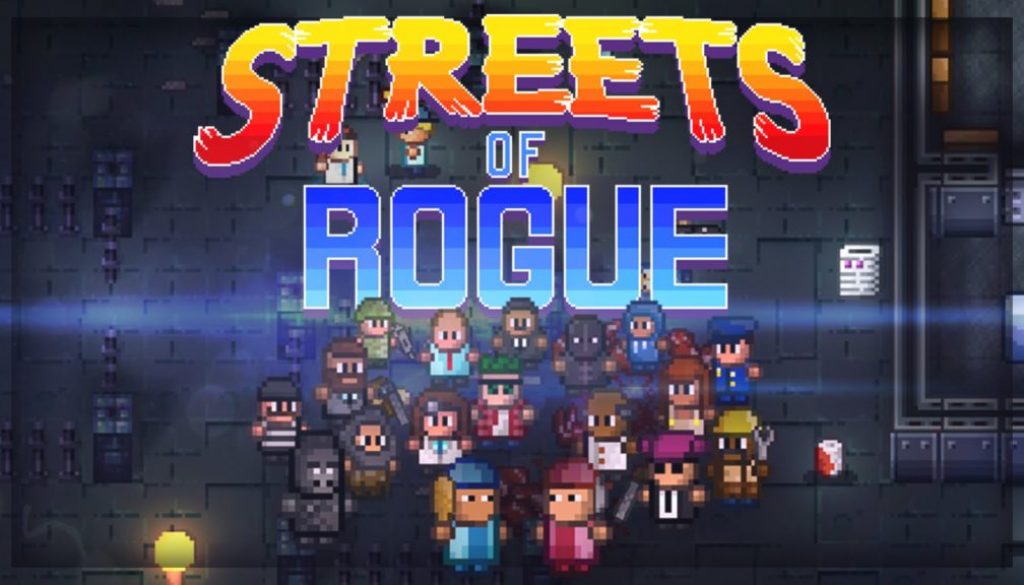Thoughts on the Streets of Rogue Alpha
Streets of Rogue, developed by Matt Dabrowski, came to my attention when I watched one of Super Bunnyhop’s latest videos. Before you go on, check that video out. It’s pretty spot-on in most places, but it doesn’t quite give the game the in-depth look that it deserves.
Now, given that roguelikes are not only my jam but also quite possibly my peanut butter and bread, I had to give the game a shot. What I expected was a top-down dungeon crawler themed around exploring the slums and shooting guns.
What I got was closer to Deus Ex, if it was made by lunatics.
Well, that’s not completely true. Streets of Rogue is what would happen if Deus Ex, Fallout, and Hotline Miami had a baby with GTA. As the website says, it’s the world’s only “RPG Roguelike Action Stealth Shooter Brawler Co-Op Megagame”. I can confirm that this is, in fact, the case – there is quite simply nothing else like it.
The complex nature of the game can be missed by a first-time player. Streets of Rogue is all about multiple layers of artificial intelligence interacting with each other, with or without the player’s cooperation. This can often cause conflict between NPCs which end up boiling over into fights which can spill out of control drastically and eventually pull in the player, like a whirlpool of violence. It’s wonderful.

Let’s use an example to illustrate that particular point:
My character is a thief. I move fast, and can steal things from NPCs who are looking in the wrong direction. I make the mistake of pick-pocketing a slum dweller that turns around at the wrong time, and suddenly he’s wailing on me with his fists and I’m backing way, way up before I get wrecked. Lucky for me, I’ve paid a local gang member to follow me and assist me in my nefarious acts. He springs into action, and begins shooting at the slum dweller. Unfortunately for him, his gunfire attracts the attention of a member of the opposing gang, who begins taking potshots at my guy. Uh oh, he brought some friends who are firing off at the crowd that has gathered to watch the show. Oops, he shot one. Oops, a cop saw that, and the cop is bringing all his friends. Oops, it’s a riot! Oops, someone got punched so hard they got slammed through a wall of a goon hideout, and now the criminals inside are out for blood, and…
Ok, I think you get it. Unless you’re very careful, things can spiral out of control very quickly. That’s a game design philosophy that’s been around since the earliest roguelikes, and despite Streets of Rogue‘s man departures from classic roguelike formula, in this respect it upholds the finest traditions of the genre. A careful player can minimize the chances of things going haywire in numerous ways, from minimizing witnesses to bribing officials to using stealth to sneak around any dangers.
Now, here’s the big switch-up: The game puts you in out-of-control scenarios once every three floors.
Sometimes you’re being chased by a nigh-unkillable evil robot who shoots never-ending rockets at you. Sometimes bombs are falling from the sky. Sometimes there are ticking time bombs hidden around the level and if you don’t find them all in two and a half minutes, you explode.
All of these situations prevent you from playing carefully, and add massive amounts of chaos into the mix, preventing careful play by lacing the game with an added layer of unpredictability. It’s not an unheard-of mechanic in roguelikes; Dwarf Fortress adds goblin sieges from time to time in order to shake up gameplay, The Binding of Isaac adds floor-wide effects like darkness or amnesia to hinder players, and Crypt of the Necrodancer speeds up gameplay on every floor making it easier for slip-ups to happen. This messy chaos is a staple of many roguelikes, but Streets of Rogue puts it to excellent use. A clever player can even use many of these disasters to their advantage, if they have the skills and coordination to pull it off.

Another big way that Streets of Rogue stands out from the crowd, even at this early alpha stage, is through its varied classes.
One thing I notice when playing roguelikes is that the all start off almost exactly the same, regardless of what class you choose. In Nethack, it doesn’t matter whether you’re a wizard or a valkyrie, you’re gonna be running up to enemies and bumping into them until either they fall down, or you do. In Sword of the Stars: The Pit, you’re gonna be punching and knifing a lot of guys for the first ten minutes of your run. Heck, even in more rogue-“lite” games like The Binding of Isaac, you’re gonna start each game by doing minimal damage with low stats.
Streets of Rogue throws that out the window. You can start off with a machine gun and regenerating health, if you want. You can start with nothing but a bottle of whiskey. You can even start with an inventory full of drugs and chemicals, or crazy laser rays that blow up ghosts.
But that’s just the start.
At the time of writing, there are currently 22 different characters that you can play as, with eight more planned to be added soon. Each of them have their own sets of stats, like speed and accuracy, but the main difference in the classes is not how hard they can punch and how fast they can run. No, it all comes down to their insane secondary attributes and abilities, which drastically change the way that the game gets played with every run.
The gorilla, for example, can punch harder than anybody else. He can use melee weapons to break through windows, and can gib people into a glorious spray of blood because he just hits so damn hard. As a trade-off, he can’t speak to anyone except other gorillas (a rarity) and can’t use guns or complicated tools. This lends itself to a fast-moving and hard-hitting play style that sees the player smashing his way through obstacles and punching his way out of situations.
The zombie, on the other hand, is a new class just added a few days ago. Zombies either cause people to run away or attack on sight, but can also convert up to five NPCs to their aid by making physical contact with them. Already have five zombies rallied to your cause? Well, the enemy still becomes a zombie after death, but they become their own free agent, running around and killing people as they see fit. It’s pure chaos.
One last example to illustrate the differences between the available play styles: The cop. The cop can use firearms decently well, and has above average stats, but his main power lies in his ability to arrest people. Anyone who isn’t actively attacking you can be arrested and rendered effectively neutralized. On the other hand, attacking and arresting innocent civilians will cause you to lose experience points, so it’s most effective to stay on the side of the law as you progress, arresting the bad guys and protecting the innocent.
As you can tell, no two characters play alike. It’s not just a matter of weapon proficiency or starting attributes; no, it’s almost like each character is playing an entirely separate game from other characters.

This brings us to Co-Op, which is where things go insane.
A friend and I both purchased the game after seeing it played, and we’ve had many co-op runs since. Co-Op is… well, it’s a mess. But in a fun way! It’s like a salad that’s being made by two chefs at once, but neither of them is trying to make the same kind of salad. One chef adds lettuce, the other adds bacon bits. One adds kale, the other adds crunched up pieces of tortilla chip and taco meat. One adds tomatoes and the other addsHOLY SHIT HE THREW A LIT STICK OF DYNAMITE IN THE SALAD, EVERYBODY RUN!
In the single player, you have a lot of control over your own situation, and with some practice, you can figure out the rules that the AI plays by, and can avoid a lot of tricky situations. Multiplayer, on the other hand, strips that control away from you entirely. I’ll illustrate with one small example.
My buddy was a cop, and I was a shapeshifter. Cops hate shapeshifters, they kill them on sight, but that rule doesn’t apply when the cop is another player. The problem, though, was that I’d gotten so used to not being shot at by a cop that I forgot all about that rule for one terrible moment, and ended up taking off my disguise in the middle of a police station. Things went poorly after that.
Now, the game is still in Alpha, as I stated before. It is unfinished. only 3/5ths of the game’s planned levels are available to play, so at this time it’s still impossible to “beat” the game. A lot of classes are currently unavailable. There are some bugs every now and then – I saw a guy get punched so hard he went inside a wall and got trapped there.
The game isn’t perfect, but the amount of potential demonstrated by Matt Dabrowski is incredible, and I eagerly await the arrival of every new update. He’s done a fantastic job so far, and I can’t wait to see what happens next.
For gameplay footage, and an example run, check out my Youtube channel.
This article describes the state of the game as of 7/18/2017.
Powered by WPeMatico



